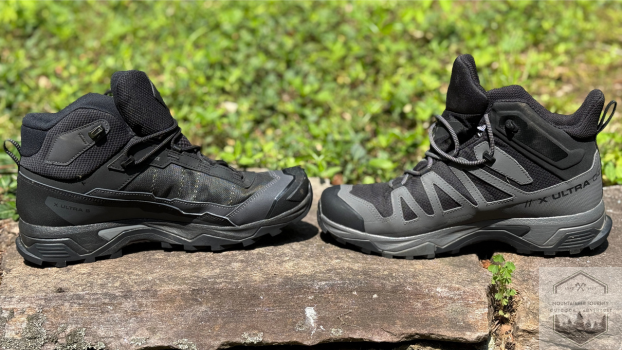What Is The ADV-C Chassis? Tested & Reviewed

In this article, we are going to review what the Salomon advanced chassis is, how it works, and whether it is worth it. At the end of the article, I will be giving my honest opinion and personal experience with the ADV-C chassis system.
What is a Chassis?
Similar to a car, the chassis serves as the foundation for the construction of a hiking boot. It improves the boot’s stability and structure. The majority of hiking boots use thermoplastic for their chassis. The chassis’s primary goal is to provide lateral stability, which many hikers struggle with.
Hikers often struggle with lateral stability when they encounter rough terrain. In rough terrain, your ankle plays a crucial role in stabilizing your foot.
Failure to do so can lead to oversupination or overpronation, potentially causing injury to your ankle ligaments. Obviously, preventing injuries is one of the most important steps to keeping you on the trails longer.

What is the Salomon Advanced Chassis?
The Salomon Company developed the ADV-C Chassis system to enhance the stability and performance of hiking boots. The Salomon X Ultra 4 and Salomon Quest 4 feature the ADV-C chassis on the lateral side of their hiking boots. Plastic and rubber combine to form a robust buttress, enhancing lateral stability during hiking.
One of the excellent things about the ADV-C chassis is that it is a very rigid construct that allows for flexibility when needed. As I’ve stated in my previous articles, your hiking boots must have a perfect balance between flexibility and stiffness.
An overly flexible hiking boot will conform to an uneven surface, causing slipping and reducing traction. A stiffer hiking boot, on the other hand, will not conform to the surface and will allow the lugs to grab a tight grip on the uneven terrain, leading to better traction.
Most of the support produced by the ADV-C Chassis is in the mid foot area, where most hikers will experience injury.
Additionally, the ADV-C chassis allows for better forefoot propulsion, improves stride, and overall reduces foot fatigue. Having a stable construct in the mid foot means you don’t have to plantar flex your foot with additional force to have an efficient stride.
Is the ADV-C chassis worth it?
In my opinion, Solomon really takes their customers concerns seriously. Salomon’s development and manufacturing of the ADV-C is a testament to the company’s meticulous attention to detail. Since a lot of hikers complain about lateral ankle sprains, Salomon has incorporated the ADV-C chassis into all hiking shoe models.
The added benefit of stability and an efficient stride makes hiking that much better. In my expert opinion, I believe the ADV-C chassis is a small step towards improving your hiking, but at the end of the day, it is worth it.
My experience with the ADV-C Chassis
I have tested two Salomon hiking boots, the Salomon X 4 Ultra and Quest 4, and, I must say, I really did notice a difference in lateral stability while hiking. The boots have a stable construction, but they are not overly stiff to the point where they cause discomfort.
While using Quest 4 in the Catskills, I faced a lot of rough terrain and had zero issues with stability. The Advanced Chassis System Salomon has incorporated into my hiking game, allowing me to worry less about ankle injuries and stability while hiking. Overall, I believe other companies will start incorporating this construct into their hiking boots.
Frequently Asked Questions
What do Salomon Advanced chassis achieve?
Aided lateral stability, reduced ankle injuries, and a more efficient stride.
Are the ADV-C chassis featured on other Hiking Boots?
Currently Salomon creates the ADV-C chassis for their own hiking shoes. Other hiking boots do have an advanced chassis but do not have the same construct as Salomon’s.
Adventure Awaits,
Tyler






